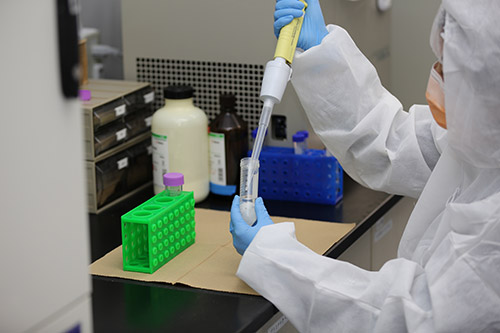
ORTHOREBIRTH has been carrying out various kinds of researches and studies by applying our own microfiber technology, based on which we developed our flagship, ReBOSSIS, cottony-type bone-void-filling material, into many medical fields, especially into regenerative medicine. The progress of different kinds of researches we have been making is quite different:Some researches of ours have just started, some have progressed so well to a stage where we can feel our success in the future and other researches have already led to product commercialization. This sections shows you the outline of our major researches.
Cell-Culturing Base Material
-We have been researching and developing proper base materials to be used for extracting and culturing Adipose Stem Cells (ASC). This R&D is carried out jointly with University of the Ryukyus in Okinawa. If you use the base material we have developed, you can extract ASCs from a lump of fat easily and culture ASCs highly efficiently.
-Our developed base material, made of microfibers, can be also utilized as scaffolding material of bioabsorbable property to be used for 3D tissue regeneration. This is another function of this base material. It was already commercialized as our product, named “Stem Cell Culture/Extract Sheet for Research Purposes.” This sheet has been on sales since December 2018.
Mixed Use of BMP and Our Cottony-Type Artificial Bone
– A commonly-seen treatment of bone defect or dysgraphia, caused by bone tumor or injury, is to use a bone taken from the patient’s iliac bone and graft this bone to the affected part. This method is called Autogenous Bone Graft. However this method comes with various problems. For example, the Q’ty of obtainable bone is not enough, the patient has much postoperative pain in the area where the bone was taken, the patient has a risk of bone fracture and so on.
-In order to solve these problems, the treatment method based on the utilization of Bone Morphogenetic Protein:BMP) has been mainly researched. BMP helps the forming of bones and so it is an essential protein in promoting physiological bone formation of every type including skeletal framework formation and curing bone fractures.
– In the States, two types of BMP (BMP-2 and BMP-7/OP-1) have been already certified by FDA (Food and Drug Administration). In the field of orthopedics, the clinical application of BMP-2 has been promoted (the same thing goes for Europe). However, it is reported that BMP comes with one problem or “Ectopic Ossification (that is, a bone is formed in a non-desired area in a patient’s body)” due to BMP’s own properties:strong bone induction ability and BMP cannot stay at one area for a long time.
– Then, in order to get rid of BMP’s disadvantages, we have been trying to combine BMP with our cottony-type artificial bone material. For example, we are going to develop a new hybrid formulation which works to promote the safe regeneration of bones by integrating our cottony artificial bones containing β-TCP (which is responsible for bone formation) with BMP. This hybrid formulation is expected to be able to respond to treatment of larger-sized bone defect thanks to beneficial function of BMP. In our research stages, we have got satisfactory results.
Then, we are currently making experiments on animals to test this formulation.
Antibacterial Cottony-Type Artificial Bone-Void-Filling Material
-In rapidly-aging country, Japan, it is expected that the number of bone or joint operations will increase more than before. At the same time, it is highly important for us to prevent any surgery areas from being bacteria-infected (postoperative infection).
-Then, ORTHOREBIRTH started a project to develop “Antibacterial Cottony-Type Artificial Bone-Void-Filling Material which is featured with both antibacterial property to prevent postoperative infection and excellent handling.” We, ORTHOREBIRTH together with three partners such as Meiji University, Nagoya Institute of Technology (NIT), Keio University have been making joint R&Ds under this project.
– This project has been designated by NEDO (New Energy and Industrial Technology Development Organization, a national R&D corporation) as a three-year-long commissioned project since FY 2016. Since then, this project resulted in a certain research achievement. If our project of this becomes successful in practicalization, a great reduction in postoperative infection will be highly expected and also our commitment will greatly contribute to the improvement of patients’ QOL, we believe.
Application of Cottony-Stuff as Medicine Carrier.
-Our flagship, ReBOSSIS. It is a cottony-type bone-void-filling material. Our cottony material is featured with several advantages: Excellent in bioabsorbability, Leaving nothing inside a patient’s body, It is easy to shape and we can knead medical ingredients of any kind into the fibers of a cottony material. Based on these features, we developed the application of our cottony material as Drug Delivery System-that is, we devised our cottony material as cottony carrier of medical ingredients. In this application, we can knead medical ingredients of various kinds into cottony fibers, instead of bone-regenerating ingredients, and let such medical ingredients release slowly inside a patient’s body.
-This research and development has been carried out by National Institute of Technology, Okinawa College and OTHOREBIRTH’s Okinawa Laboratory. They repeated an experiment in which they kneaded anti-cancer agent as medical ingredient into a cottony material and implanted this cottony material into mice with cancer. After repeating this experiment, we had a successful result.
-It is gentle to a patient’s body to implant a cottony material containing anti-cancer agent at an affected area inside the body, make such cottony material stay at the area and release the anti-cancer agent slowly for a period of time. On the other hand, general types of anti-cancer agent, oral or drip administration, go around a patient’s body, making its side effects stronger against the patient. On the other hand, however, a cottony material, containing anti-cancer agent staying at an affected area inside a patient’s body for a certain period of time, is highly expected to exercise its anti-cancer effect for a long time and also reduce its side effect against a patient.

